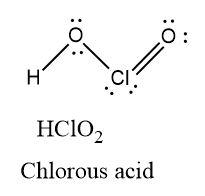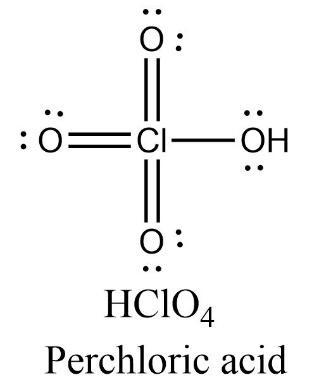
Answer
463.2k+ views
Hint: Draw the structure of the molecules. Determine the number of double bonds present in them. Also, determine the number of lone pairs on chlorine atoms in each structure. Find out the oxidation states of Cl atoms in each structure.
Complete answer:
Chlorine forms four types of oxyacids:
-Hypohalous acid: Hypochlorous acid

Hypochlorous acid has one oxygen atom containing two lone pairs of electrons and one chlorine atom containing three lone pairs of electrons. There are no double bonds present in the molecule.
\[\text{Oxidation state }=\text{ }+1\]

Chlorous acid has two oxygen atoms containing two lone pairs of electrons each and one chlorine atom containing two lone pairs of electrons. There is one $Cl=O$ double bond present in the molecule.
\[\text{Oxidation state }=\text{ }+3\]
-Halic acid: Chloric acid

Chloric acid has three oxygen atoms containing two lone pairs of electrons each and one chlorine atom containing one lone pair of electrons. There are two $Cl=O$ double bonds present in the molecule.
\[\text{Oxidation state }=\text{ }+3\]
-Perhalic acid: Perchloric acid

Perchloric acid has four oxygen atoms containing two lone pairs of electrons each and one chlorine atom containing no lone pair of electrons. There are three $Cl=O$ double bonds present in the molecule.
\[\text{Oxidation state }=\text{ }+5\]
Now, let’s take a look at the options given in the question.
(A) It is correct because the number of $Cl=O$ bonds in $HCl{{O}_{2}}$ and $HCl{{O}_{3}}$ together is three.
(B) It is correct because the number of lone pairs of electrons in $HCl{{O}_{2}}$ and $HCl{{O}_{3}}$ together is three.
(C) It is incorrect because the hybridization of $Cl=O$ in $HCl{{O}_{4}}$ is $s{{p}^{2}}$.
(D) We know that as the oxidation state increases, acidity increases. In this case, the oxidation state of Perchloric acid is +7. So, Perchloric acid is the strongest acid amongst other oxyacids of chlorine.
Order of Acidity can be given as,
$HCl{{O}_{4}} > HCl{{O}_{3}} > HCl{{O}_{2}} > HClO$
So, we can conclude that option (D) is also incorrect because it states hypochlorous acid is the strongest acid.
So, the correct answer is “Option A and B”.
Note: Mistakes can happen while drawing the structure of molecules. Remember, a doubly bonded oxygen atom has two lone pairs and a singly bonded chlorine atom has three lone pairs.
Complete answer:
Chlorine forms four types of oxyacids:
-Hypohalous acid: Hypochlorous acid

Hypochlorous acid has one oxygen atom containing two lone pairs of electrons and one chlorine atom containing three lone pairs of electrons. There are no double bonds present in the molecule.
\[\text{Oxidation state }=\text{ }+1\]

Chlorous acid has two oxygen atoms containing two lone pairs of electrons each and one chlorine atom containing two lone pairs of electrons. There is one $Cl=O$ double bond present in the molecule.
\[\text{Oxidation state }=\text{ }+3\]
-Halic acid: Chloric acid

Chloric acid has three oxygen atoms containing two lone pairs of electrons each and one chlorine atom containing one lone pair of electrons. There are two $Cl=O$ double bonds present in the molecule.
\[\text{Oxidation state }=\text{ }+3\]
-Perhalic acid: Perchloric acid

Perchloric acid has four oxygen atoms containing two lone pairs of electrons each and one chlorine atom containing no lone pair of electrons. There are three $Cl=O$ double bonds present in the molecule.
\[\text{Oxidation state }=\text{ }+5\]
Now, let’s take a look at the options given in the question.
(A) It is correct because the number of $Cl=O$ bonds in $HCl{{O}_{2}}$ and $HCl{{O}_{3}}$ together is three.
(B) It is correct because the number of lone pairs of electrons in $HCl{{O}_{2}}$ and $HCl{{O}_{3}}$ together is three.
(C) It is incorrect because the hybridization of $Cl=O$ in $HCl{{O}_{4}}$ is $s{{p}^{2}}$.
(D) We know that as the oxidation state increases, acidity increases. In this case, the oxidation state of Perchloric acid is +7. So, Perchloric acid is the strongest acid amongst other oxyacids of chlorine.
Order of Acidity can be given as,
$HCl{{O}_{4}} > HCl{{O}_{3}} > HCl{{O}_{2}} > HClO$
So, we can conclude that option (D) is also incorrect because it states hypochlorous acid is the strongest acid.
So, the correct answer is “Option A and B”.
Note: Mistakes can happen while drawing the structure of molecules. Remember, a doubly bonded oxygen atom has two lone pairs and a singly bonded chlorine atom has three lone pairs.
Recently Updated Pages
Identify the feminine gender noun from the given sentence class 10 english CBSE

Your club organized a blood donation camp in your city class 10 english CBSE

Choose the correct meaning of the idiomphrase from class 10 english CBSE

Identify the neuter gender noun from the given sentence class 10 english CBSE

Choose the word which best expresses the meaning of class 10 english CBSE

Choose the word which is closest to the opposite in class 10 english CBSE

Trending doubts
Sound waves travel faster in air than in water True class 12 physics CBSE

A rainbow has circular shape because A The earth is class 11 physics CBSE

Which are the Top 10 Largest Countries of the World?

Fill the blanks with the suitable prepositions 1 The class 9 english CBSE

One Metric ton is equal to kg A 10000 B 1000 C 100 class 11 physics CBSE

How do you graph the function fx 4x class 9 maths CBSE

The Equation xxx + 2 is Satisfied when x is Equal to Class 10 Maths

Give 10 examples for herbs , shrubs , climbers , creepers

Change the following sentences into negative and interrogative class 10 english CBSE




